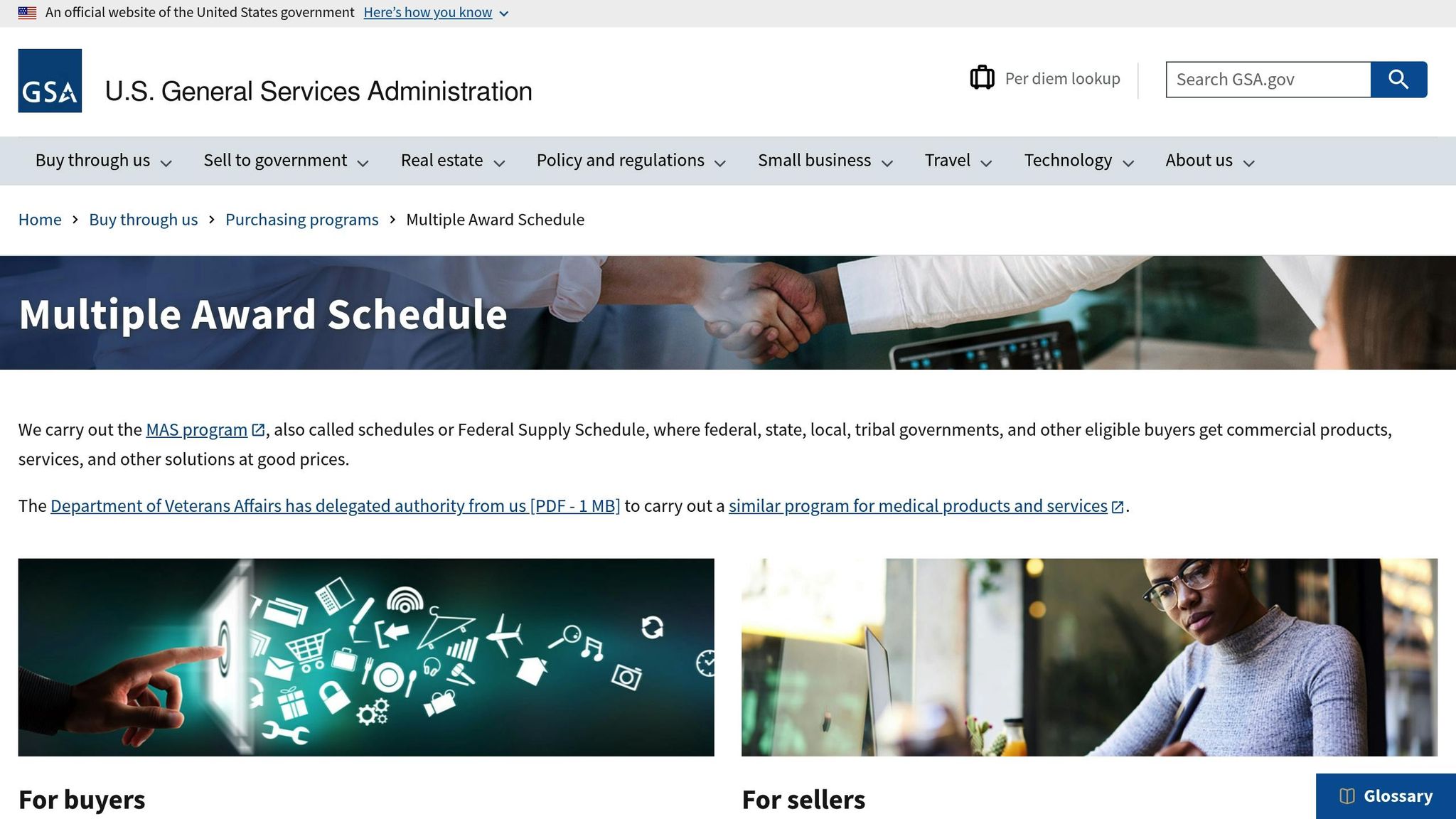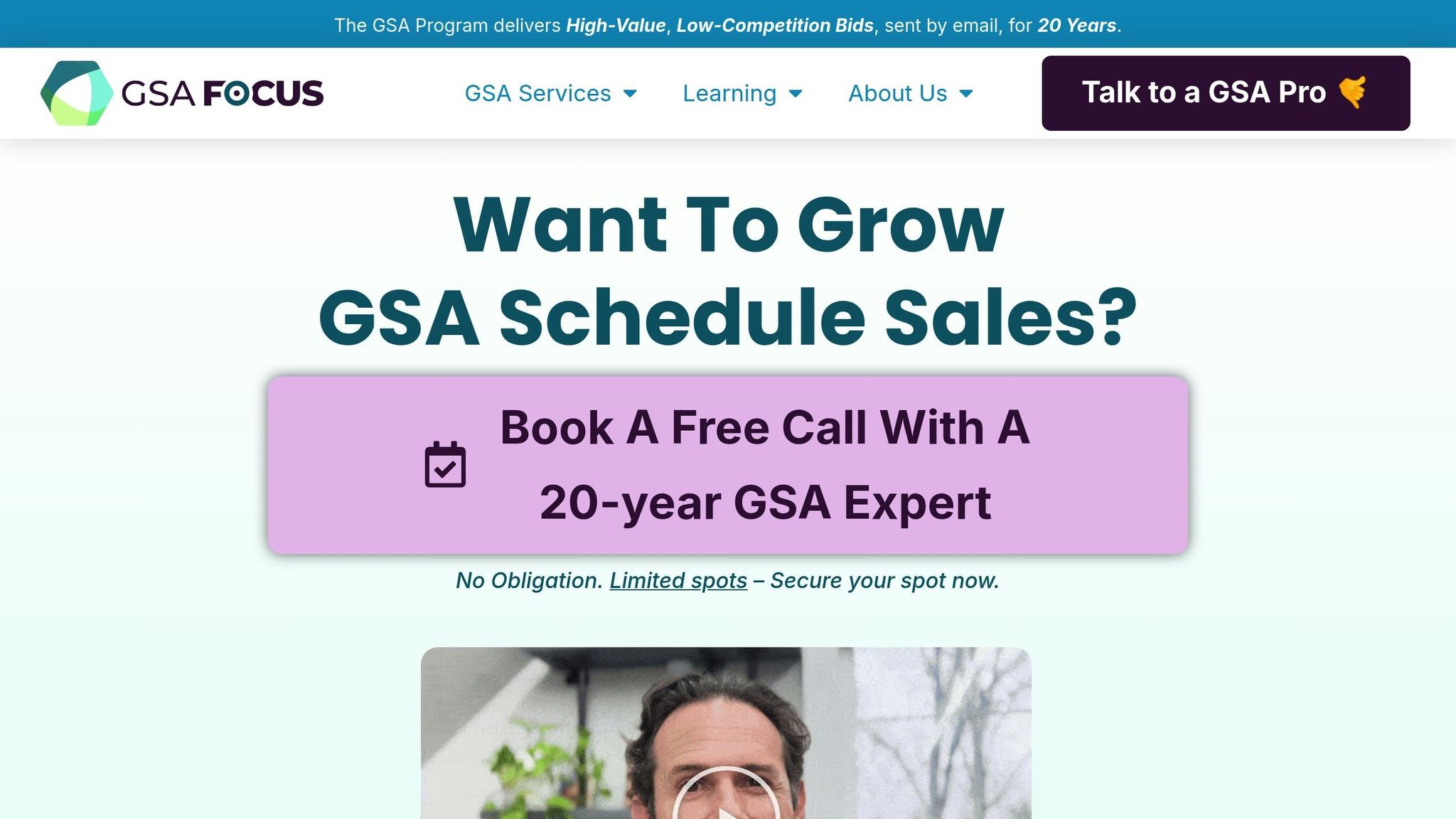Crafting a technical proposal is about presenting a clear, compliant, and persuasive roadmap to meet government contract requirements. Here’s a quick guide:
- Understand the Purpose: A technical proposal outlines how you’ll meet the contract’s needs, showcasing your team’s expertise and approach.
- Key Sections:
- Executive Summary: Summarize your solution, align it with the agency’s goals, and highlight your strengths.
- Project Scope and Goals: Define deliverables, timelines, and measurable outcomes tied to the agency’s mission.
- Technical Approach and Management Plan: Detail your methodology, risk management, and project execution strategy.
- Preparation: Research the agency, review the RFP carefully, use a compliance matrix, and ensure all team roles are clear.
- Formatting and Presentation: Use clear headings, bullet points, visuals, and adhere to U.S. standards for formatting and submission.
A strong proposal focuses on precision, compliance, and relevance to the agency’s needs. By following these steps, you can create a proposal that stands out and increases your chances of securing the contract.
Technical Proposal Writing
Main Parts of a Technical Proposal
A technical proposal is built around sections that clearly outline your solution, helping federal agencies see how you meet their needs. Understanding these core parts and their purpose will set you up to craft a proposal that grabs attention and checks all the right boxes. Below, we break down the main components that form the foundation of a strong technical proposal.
Executive Summary
The executive summary is your chance to make a strong first impression. This brief, one- to two-page section should follow your table of contents and cover letter, offering a compelling overview that encourages decision-makers to keep reading. Think of it as your elevator pitch – short, impactful, and tailored to the agency’s needs.
Start by addressing the agency’s pain points and showing how your solution is the perfect fit. A great way to structure this is using the P-A-S framework: highlight the Pain, stir up the urgency by Agitating the problem, and present your Solution as the answer. Be specific – mention the agency by name, reference relevant branches or operations, and include data like financial projections to back your claims.
This section should also spotlight your company’s strengths. What makes you stand out? Highlight your qualifications, past successes, and the unique value you bring to the table. Tie these strengths directly to the agency’s goals and federal contracting needs. Wrap it up with a clear call to action, guiding the reader toward the next steps, such as scheduling a meeting or reviewing additional details.
Project Scope and Goals
Here’s where you define exactly what you’ll deliver and how it aligns with the agency’s mission. This section needs to be crystal clear about the work involved, the deliverables, timelines, and any challenges you anticipate – all while ensuring you meet the requirements outlined in the solicitation.
Start by showing that you understand the agency’s challenges. Dive into their mission and objectives, weaving that understanding into your scope definition. This demonstrates not only your technical expertise but also your grasp of the bigger picture.
Your project goals should be measurable and directly tied to the agency’s desired outcomes. Spell out what success looks like and how you’ll track it. This level of detail shows that you’re not just meeting the technical specs but also working toward the broader purpose of the contract. Address how your approach solves their problems while staying within their constraints and expectations.
Technical Approach and Management Plan
This is the heart of your proposal, where you explain how you plan to execute and manage the project. Your technical approach should cover your methodology, technology choices, risk management strategies, and cost-efficiency measures. This section is your opportunity to show that you’ve thought through every detail.
Lay out a step-by-step plan for completing the work, and include a workflow graphic to give a clear visual of your process. Be sure to touch on all key activities, collaborations, timelines, and even target populations if relevant. Support your plan with examples of past performance to prove your capability, but tailor everything to the agency’s specific goals – avoid cookie-cutter templates.
Your management plan should detail how you’ll mitigate risks, handle communication, and track performance. Address potential challenges head-on and explain how you’ll resolve them proactively. This section should demonstrate not only your technical expertise but also your ability to manage the project effectively and adapt to any hurdles.
Both the technical approach and management plan need to reflect a deep understanding of the project’s context and the agency’s needs. It’s about showing that you’re reliable, trustworthy, and fully aligned with their mission. These are the elements that build confidence and help you stand out in federal contracting. Next, we’ll guide you through writing your technical proposal step by step.
Step-by-Step Guide to Writing a Technical Proposal
Creating a successful technical proposal starts long before the Request for Proposal (RFP) lands in your inbox. It requires careful planning, strategic research, and a clear understanding of the requirements. Here’s a detailed guide to help you navigate the process from preparation to submission.
Pre-Tender Preparation
The groundwork you lay before the release of an RFP can make or break your proposal. Start by researching the federal contracting landscape to understand potential opportunities and align your project goals with agency objectives. This early preparation helps position your company strategically.
Set up a tender register to track critical information like upcoming opportunities, submission deadlines, and agency contacts. When a relevant RFP is released, log all essential details – submission requirements, evaluation criteria, and the contracting officer’s contact info. Notify your management and technical teams promptly to allocate resources efficiently.
Ensure your company’s financial documents, bonding capacity, and insurance coverage are up to date. Many federal contracts require specific bond amounts, so verify that your bonding qualifications meet the standards of your target bids.
Take an honest look at your technical capabilities. Identify any specialized tasks, such as surveys or designs, that may require external expertise. Build relationships with qualified subcontractors and create a resource availability matrix to track workload and resources. This matrix will guide your decisions on which bids to pursue.
Once your preliminary work is complete, shift your focus to thoroughly analyzing the RFP.
Reviewing the RFP
When the RFP arrives, your first step is to ensure your proposal will be both competitive and compliant. Carefully review the solicitation, paying close attention to sections like the Description/Specifications/Work Statement, Evaluation Factors, and Instructions to Offerors.
Develop a compliance matrix that links each RFP requirement to a specific section in your proposal. This matrix serves as a roadmap for drafting and as a checklist during the final review. Understanding the evaluation criteria is crucial for tailoring your proposal to the agency’s priorities.
Go beyond the surface-level requirements and consider the agency’s underlying challenges. Craft your proposal to show how your solution addresses these issues directly. Also, follow the submission guidelines meticulously – this includes adhering to page limits, formatting rules, and delivery methods. If anything in the RFP is unclear, seek clarification through official channels and document the responses.
Once you’ve dissected the RFP, you’re ready to start drafting and refining your proposal.
Writing and Reviewing the Proposal
Use your compliance matrix as a guide while drafting the proposal to ensure all requirements are addressed in the correct sections. Begin with sections that require detailed research, such as the technical approach and management plan. Tailor your narrative to meet the agency’s specific needs and assign clear roles to your proposal team.
Have technical experts draft specialized sections while designating one person to ensure the overall narrative remains cohesive. Define reviewer roles early, specifying whether they will focus on compliance, clarity, accuracy, or persuasiveness.
Review your proposal in stages, focusing on compliance, accuracy, clarity, and overall persuasiveness. This step-by-step approach ensures your proposal is technically sound and meets federal requirements. Allow at least a day between writing and editing to gain a fresh perspective and catch any overlooked issues.
Use a structured review process to evaluate compliance, content quality, cost alignment, and strategic fit. Review each section from the client’s perspective, identifying areas for improvement. Keep a record of recurring issues from past reviews to refine future proposals.
Before submission, double-check that your proposal complies with all formatting requirements, page limits, and submission protocols. Even the most well-thought-out solution will be dismissed if it doesn’t meet the basic submission criteria.
sbb-itb-8737801
Formatting and Presentation Tips
A polished proposal can set your bid apart from the competition. Government evaluators often sift through dozens of submissions under tight deadlines, so crafting a document that’s both professional and easy to navigate is key. Effective formatting not only enhances readability but also reinforces the technical strengths you’ve outlined. Let’s dive into some practical strategies to ensure your proposal stands out.
Making Your Proposal Easy to Read
Clarity and organization are essential for professionalism. Start with a detailed table of contents that allows evaluators to quickly locate specific sections. This is especially useful for lengthy proposals where quick cross-referencing can save time.
Align your section headings with the exact language used in the RFP. For example, if the solicitation asks for a "Technical Approach and Management Plan", use that exact wording in your proposal. This alignment makes it easier for evaluators to find the information they need and demonstrates your attention to detail.
Break up dense text with bullet points and ample white space. Long blocks of text can obscure critical details. For instance, instead of saying, “The implementation of our innovative methodology will lead to an enhancement of operational efficiency,” simplify it to:
- "Our approach improves efficiency by 20%".
Visual aids like charts, graphs, and tables are invaluable for simplifying complex concepts and emphasizing key metrics. Since the human brain processes visuals up to 60,000 times faster than text, these elements can make your proposal more engaging and memorable.
Following U.S. Standards
Federal proposals must adhere to specific American formatting conventions, which may differ from international practices. Demonstrating your familiarity with these standards shows evaluators that you understand and respect U.S. government expectations.
Maintain consistency in fonts, heading styles, colors, and spacing throughout the document. This uniformity enhances the professional appearance of your proposal and builds confidence in your capabilities.
- Currency: Use the dollar sign ($) immediately before the amount, with commas separating thousands (e.g., "$1,250,000").
- Dates: Follow the MM/DD/YYYY format (e.g., 03/15/2025) or spell out the month (e.g., March 15, 2025).
- Measurements: Use imperial units unless the RFP specifies metric.
- Spelling: Adopt American spelling conventions, such as "organize", "color", and "analyze."
- Numbers: Use commas for thousands and periods for decimals (e.g., 1,234.56).
Once you’ve ensured compliance with U.S. standards, move on to a thorough final review.
Final Review Checklist
Before hitting "submit", conduct a meticulous review to catch any formatting errors that could hurt your evaluation score. Government agencies enforce strict guidelines, and as Anna Rose from USFCR Training warns:
Ignoring or overlooking instructions can lead to the disqualification of your proposal.
Here’s a checklist to guide your final review:
- Confirm all RFP formatting requirements, including font sizes, margins, line spacing, and page limits.
- Ensure every page includes your company name, proposal date, and solicitation number.
- Proofread for grammatical errors, typos, and formatting inconsistencies.
- Print key pages in grayscale to verify that charts and tables remain legible.
- Double-check submission details, including the delivery method, deadline, and packaging instructions.
Getting Expert Help for GSA Schedule Proposals

Crafting a strong technical proposal for federal contracts is no small feat. The process is packed with strict compliance rules, extensive documentation, and precise formatting standards that can overwhelm even seasoned professionals. For small businesses, tapping into expert help – like the services offered by GSA Focus – can make all the difference between landing a contract or missing out. Let’s take a closer look at how GSA Focus can simplify the process and open doors to federal contracting opportunities.
About GSA Focus

Navigating the complexities of GSA Schedule contracts often requires specialized knowledge, and that’s where GSA Focus comes in. They aim to bridge the gap in the federal contracting world, where only 4% of small businesses hold GSA Schedules.
GSA Focus operates as a full-service consultancy, managing every step of the GSA Schedule acquisition process. Instead of leaving businesses to decode intricate requirements, they provide a "done-for-you" service that includes preparing documents, ensuring compliance, and supporting negotiations.
Their approach is built to save time and reduce headaches. With over 600 clients served and a 98% satisfaction rate, GSA Focus has a proven track record of transforming technical know-how into proposals that meet federal standards and win contracts.
Why Choose GSA Focus?
One of the biggest advantages of working with GSA Focus is the time savings. Typically, applying for a GSA Schedule can take over 100 hours, but GSA Focus reduces this dramatically – business owners only need to invest about 3 hours of their time. On top of that, the average return on investment is an impressive 87×.
The financial perks don’t stop there. Many clients see their revenue grow by roughly $927,000 annually after securing a GSA Schedule.
Compliance is another area where GSA Focus shines. They handle 95% of the paperwork and provide ongoing support to ensure businesses stay compliant even after contracts are awarded. Their 98% success rate speaks volumes, and they back their services with a refund guarantee: "We guarantee your success with the GSA Program, or you don’t pay a cent."
By partnering with GSA Focus, businesses also gain access to a vast federal marketplace, opening the door to opportunities that might otherwise remain out of reach.
Opening the Door to Federal Contracts
Working with GSA Focus connects small businesses to a lucrative federal marketplace. In fiscal year 2023 alone, the federal government awarded over $3.3 billion in contracts to small businesses, with more than half of GSA’s eligible spending directed toward small business categories.
GSA Schedule contracts offer even more benefits, including a potential 20-year performance period (a 5-year base with three optional 5-year extensions). With pre-negotiated pricing, terms, and conditions, these contracts make it easier for government buyers to place orders, often leading to repeat business.
Beyond securing contracts, GSA Focus helps businesses meet essential benchmarks, like reaching $25,000 in GSA sales within the first two years and maintaining that annually. Their post-award support ensures businesses stay on track and fully leverage their contracts.
For businesses looking to tap into consistent revenue streams while avoiding common pitfalls, GSA Focus provides the expertise needed to succeed in the federal marketplace. Their deep understanding of GSA requirements and technical proposal writing equips clients for long-term growth and success.
Conclusion
Creating a successful technical proposal requires more than just putting your services on paper. It’s about strategic planning, attention to detail, and a thorough understanding of government requirements. A strong proposal doesn’t just tell – it shows. It demonstrates your expertise and your ability to deliver measurable results.
The foundation of any winning proposal lies in fully understanding the RFP and aligning your response with the agency’s specific needs. This means carefully examining every detail, preparing compliance checklists, and crafting an executive summary that grabs attention right away. Your technical approach should highlight practical solutions, backed by relevant past performance, while emphasizing what sets you apart from the competition.
"Technical proposals are more than a formality. They are the proof that you understand the project, the client, and how to deliver real results."
– ACE Consulting
Clarity and compliance are your best tools in the competitive world of federal contracting. Government evaluators value proposals that are clear, follow formatting rules to the letter, and proactively address potential risks. Every detail matters – whether it’s your project timeline, quality control measures, or risk mitigation strategies. Each component of your proposal contributes to the overall impression you leave with evaluators. A clear and compliant submission not only meets the requirements but also sets you apart as a serious contender.
Navigating this process can be daunting, especially for businesses new to federal contracting. This is where expert guidance can make all the difference. With the complexity of GSA Schedule requirements and federal regulations, having experienced support can simplify the process and help you tap into lucrative government opportunities. Expert advice can turn a challenging process into a clear and manageable path toward success.
Investing in a well-crafted technical proposal pays off in more ways than one. It opens doors to long-term government contracts, consistent revenue streams, and the trust that comes with being a reliable contractor. Each section of your proposal contributes to a cohesive story that builds credibility and confidence. Remember, your proposal is often the first impression you make – so make it count. By following the structured approach outlined here, you can create a proposal that not only wins contracts but also establishes your reputation as a dependable partner in the federal marketplace.
FAQs
What are the most common mistakes to avoid when writing a technical proposal for a government contract?
When preparing a technical proposal for a government contract, be mindful of these frequent mistakes that can derail your efforts:
- Inconsistent formatting: A polished, professional appearance matters. Keep your formatting uniform throughout the document to ensure readability and professionalism.
- Overlooking compliance requirements: Government contracts come with strict rules. Stick closely to the guidelines and instructions in the Request for Proposal (RFP) to avoid disqualification.
- Lack of clarity: Clearly define your offerings, deliverables, and how they address the agency’s specific needs. Ambiguity can weaken your proposal.
- Failing to differentiate your business: Government contracts are competitive. Make it clear why your business is the best choice by emphasizing your unique strengths and advantages.
- Neglecting a final review: Errors can undermine credibility. Proofread your proposal thoroughly to ensure it’s error-free and fully aligned with the RFP’s requirements.
Paying attention to these details can elevate your proposal and help it stand out in a highly competitive process.
What are the benefits of using GSA Focus to help small businesses prepare technical proposals?
If you’re a small business looking to break into federal contracting, GSA Focus can make the process a whole lot easier. They specialize in simplifying the preparation of technical proposals, ensuring everything aligns with government requirements. This means less time spent worrying about compliance and more time focusing on running your business.
What sets GSA Focus apart is their personalized support. From handling document preparation to guiding you through negotiations, they provide the tools and expertise to boost your chances of landing a GSA Schedule Contract. Securing this contract can open up new opportunities for government sales and pave the way for success in the federal marketplace.
What are the best strategies to make a technical proposal stand out to federal agencies?
To grab the attention of federal agencies with your technical proposal, prioritize clear and straightforward language that gets your message across effectively. Start by tailoring your proposal to the agency’s specific goals and requirements – this means diving into their objectives and understanding their challenges. Show them how your solutions are tailored to meet their needs and why they work.
Adding visual aids like charts or diagrams can simplify complex ideas and make your proposal more engaging. Lastly, take the time to thoroughly review your work. Ensure it’s polished, free of errors, and aligns perfectly with what the agency expects. A well-prepared, professional proposal can make all the difference.
Related posts
- GSA Proposal Formatting Checklist
- Ultimate Guide to GSA Proposal Documents
- Federal Proposal Deadlines: Key Rules
- 5 Key Criteria for Technical Proposal Evaluation


